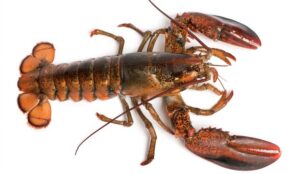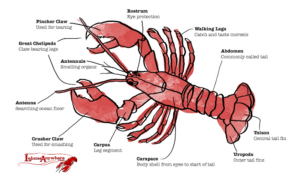Anatomy & Biology
Anatomy and Biology

Classification
Lobsters are classified in the phyllum Arthropoda (which also includes shrimp, crabs, barnacles, and insects.) The word Arthropoda comes from the Latin word “arthro”, meaning jointed, and the Greek word “poda”, foot. Hence, you will note the lobster has jointed appendages…and since lobsters are also decapods (“deca” being Greek for ten) it has ten legs (five pairs).
As invertebrate crustaceans, lobsters also have a hard outer shell or exoskeleton, and no inner skeleton or bones.
Nervous System
Invertebrates such as lobsters and insects do not have complex brains like vertebrates such as fish, birds, reptiles, or mammals do. Instead, lobsters contain 15 nerve clusters called ganglia dispersed throughout their bodies, with a main ganglion located between their eyes. Each ganglion helps to control and process sensory information in a different segment of the lobster’s body. Whether these ganglia allow them to feel pain, though, is still somewhat contested. Studies have shown they do contain nociceptors- nerves that allow the processing of noxious stimuli; however, this does not necessarily mean lobsters feel pain in the way we understand it, as pain is a subjective experience. Researchers have debated for many years whether animals without true brains have the complexity or capacity to experience pain in the way we understand it and will likely continue to debate this point for years to come as well.
Circulation
A lobster’s blood is usually greyish/clear in color. It is circulated by a heart located just behind the stomach, through a few large blood vessels. It picks up oxygen from the water through the gills, found in the lobsters’ thorax section.
Body Parts

Courtesy of: LobsterAnywhere.com
Here are the basic parts of a lobster and their function:
- Abdomen — the section commonly referred to as the “tail”.
- Antennae — tactile organs, having a sense of touch.
- Antennules — chemosensors, having a sense of smell – with a function similar to a human nose.
- Carapace — the outer shell of the cephalothrax
- Cephalothorax — contains the head and thorax sections — together they are commonly called the “body”
- Chelipod (crusher claw) — the larger of the claws, with a rounded surface suitable for crushing prey such as shellfish.
- Chelipod (ripper or pincher claw) — the smaller of the claws, which is more pointed and sharp, is used for tearing food apart.
- Eye — compound eyes provide sense of sight
- Mandible — jaw-like structure for crushing and ingesting food
- Maxillipeds — the mouth parts of the lobster, flat platelike parts used to pass food to the mandible
- Pereiopods (walking legs) — The two sets of walking legs immediately behind the claws are also used for catching and eating food and have many “taste” sensors; the last two sets of legs are used primarily for walking.
- Pleopods — commonly known as “swimmerets”. with tiny hairs. In females the hairs are somewhat longer and are the attachment point for eggs.
- Telson — the central tail fin
- Uropods — the outer pairs of tail fins
There are many informative Web sites dealing with lobster anatomy and biology that provide more detailed information. We have provided you with several links (in alphabetical order) that should give you most information you are looking for. We at the Lobster Institute are happy to answer any questions you may have as a follow up to your online research.
Lobster Biology Links
